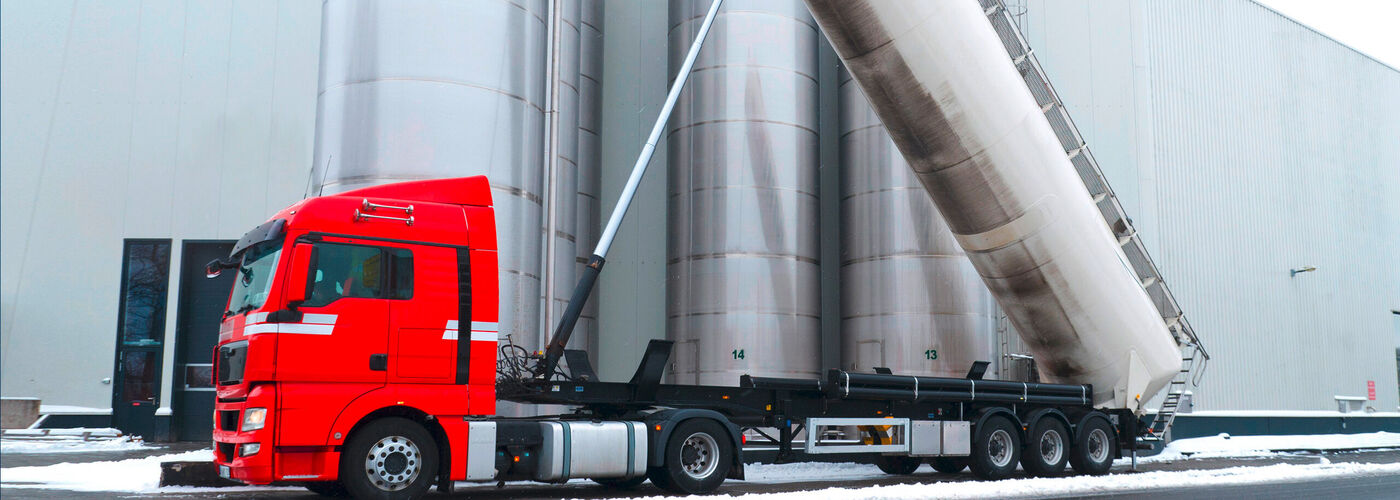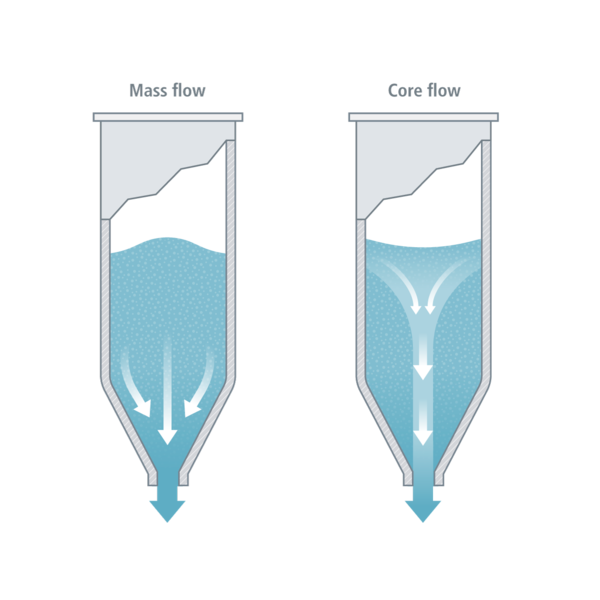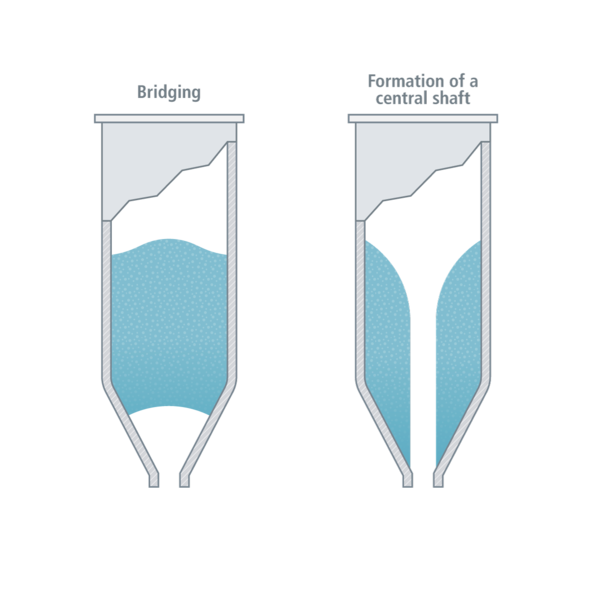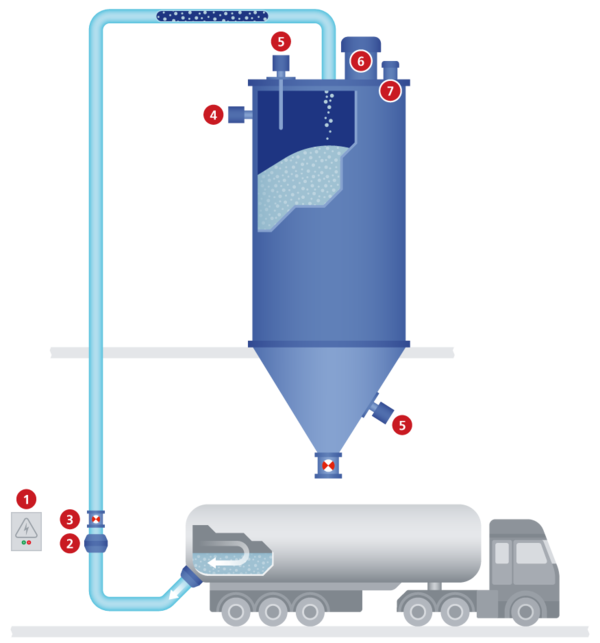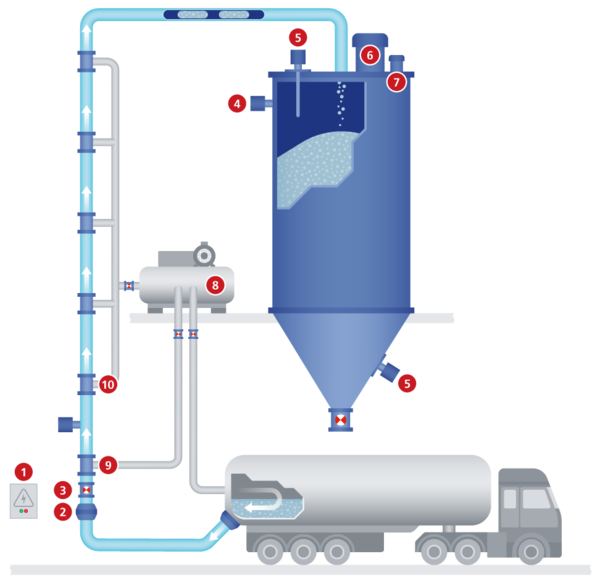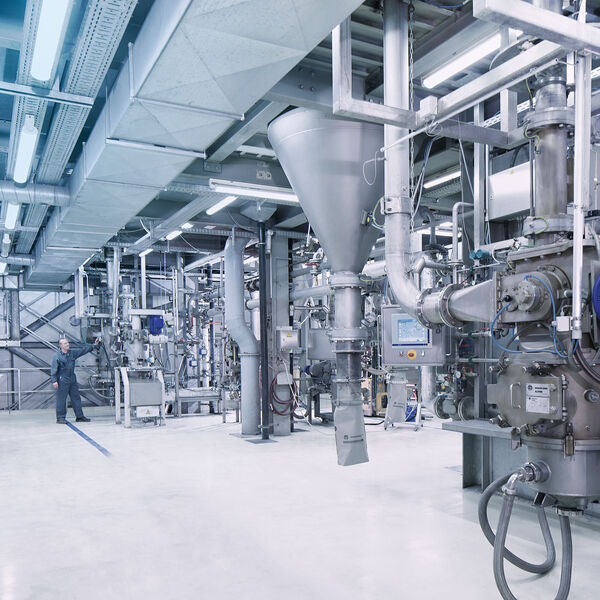Complete silo systems
Including filling devices and equipmentThroughout the production process, bulk solids have to be stored repeatedly: as raw materials, as intermediate products and as finished end products. The bulk solid is then discharged from the respective storage container and fed to the downstream process by a mechanical or pneumatic conveyor. Two factors are particularly important here:
- The individual devices (storage containers, discharge and conveying systems) must be matched to the bulk solid and the process requirements
- Also, the individual components must be coordinated with each other in terms of process engineering
Suitable silos for the product
The bulk solid that is stored in the silos is the deciding factor when it comes to developing a silo system. Ensuring that silo operation is coordinated with the product is a key factor in keeping production running reliably and maintaining the quality of the bulk solid. This involves addressing the following project-specific challenges:
- Irregular material flow
- Shooting of the material
- Segregation
- Particle degradation
- Time consolidation
- Bridging
- Formation of a central shaft
To solve these problems, our silos are designed using the Jenike method for unknown or difficult products. Here, we can rely on our large number of proven silo systems and our many years of experience. This allows us to find the right solution for you and your bulk solid.
Design and build your silo system with us!
Five steps to a customised silo system2. Process engineering design with determination of the required flow profile
The process engineering design of your silo system depends on your product and its properties. These factors influence which flow profile is required for your silo system. Possible alternatives include:
- Mass flow for "first in/first out" and discharge without segregation
- Core flow as a cost-effective solution without special conditions
- Piston flow for extremely gentle discharge with minimum grain abrasion
- Blending silo for homogenisation and conditioning
3. Material selection for your silo system
The most suitable material for your silo system also depends on the product properties and the process engineering requirements. Industry-specific specifications, such as the high hygiene requirements of the food and pharmaceutical industries, also play a role here. Possible materials could include:
- Steel silos with/without plastic coating
- Stainless steel silos
- Aluminium silos
- Plastic silos – GRP silos
- Flex-Silos
4. Silo equipment
You can choose from a variety of equipment components for your customised silo system. The most suitable components for you depends on your product and your industry. Silo equipment includes:
- Pneumatic silo filling devices
- Ventilation filters
- Safety valves
- Level monitoring
- Weighing technology
- Discharge aids
- Shut-off valves
- Dosing and conveying equipment
- Telescopic silo chutes
Technical considerations when building a silo system
Depending on the material flow during product discharge, a distinction is made between mass flow or core flow. In the case of mass flow, the entire bulk content in the silo is in motion during discharge, whereas with core flow, only partial sections are in motion
With a mass flow silo, the investment costs are higher than with a core flow silo due to higher wall thicknesses and a steeper cone. It is higher with the same storage volume. In return, the problems of irregular material flow, shooting of the material, broad dwell time range and time consolidation find a practical solution in a mass flow silo.
Taking into account the costs, the container material and the need to install as much storage volume as possible in the smallest possible space, a round or a rectangular container shape should be chosen. Round containers mainly offer cost advantages, while rectangular/square containers offer maximum storage volume.
The selected cone and outlet geometry essentially determines the outlet behaviour of the container. For example, asymmetrical cones have better discharge behaviour than symmetrical cones. Discharge behaviour can be further improved by using a slit-shaped spout instead of a round spout. However, the cones mentioned above require more overall height and make the storage container more expensive. When selecting the container shape, a compromise always needs to be found between the necessary process technology, the basic conditions on site, and the costs.
Storage of hygroscopic materials
The air volume inside the silo above the bulk solid is called “head space”. During storage, this air absorbs moisture or releases it through condensation (day/night). In the case of hygroscopic materials, the release of moisture needs to be prevented. For this reason, dry air is fed back into the silo head space.
Pneumatic silo filling devices
Most bulk solids are supplied by silo trucks or rail cars and are to be stored in a silo at the customer site. Bulk solids are often pneumatically conveyed into the silo for this purpose. We distinguish between the following systems:
Features:
- The conveying air is generated by the on-board compressor.
- The tank of the silo truck or tank wagon is the pressure container.
Used in standard applications such as:
- No special requirements for the quality of the conveying
- Cable length (horizontal + vertical) <50 m
Suitable for throughputs of:
- up to 16 m³/h with a conveyor line DN80
- up to 28 m³/h with a conveyor line DN100
Larger line diameters do not make sense, as the power of the on-board compressors is generally not sufficient.
Components:
- Local control box
- Tank wagon coupling with initiator
- Shut-off valve in the conveying pipe
- Conveying pipe system
- Overfill protection (LH), empty indicator (LL)
- Safety devices for vacuum and overpressure
- Ventilation filter
Features:
- The compressed air supplied by the truck’s on-board system is supported by compressed air (high conveying capacity) or replaced (for gentle conveying without segregation)
- The tank of the silo wagon or tank wagon is the pressure container
Use case:
- If segregation-free conveying is required (e.g. for premixes or finished products)
- If particle degradation due to abrasion is to be minimised (e.g. with sodium percarbonate, structural sand)
- At high flow rates up to 115 m³/h
- For long filling distances up to 300 m
- If no on-board compressor is available (e.g. tank wagon)
Solids Puls-Pneu truck discharger consists of the basic components of the Solids truck discharger but is extended by:
- The compressed air supply from the tank or tank wagon for controlled air supply
- The impulse valve (IV) for generating material plugs and intermediate air cushions
- The relay stations (ER) with bypass air system to avoid blockages and for gentle, segregation-free conveying
- Increase of the nominal pipe diameter in the conveying run for particularly gentle conveying without segregation.
1 on site control box 2 TW-coupling 3 shut-off valve in the delivery line 4 overpressure sensor 5 overfill protection & empty indicator 6 vent filter 7 overpressure protection 8 compressed air supply 9 impulse valve 10 relay stations
Silo equipment from Hosokawa Solids
Discharge equipment for silos and containers:
- Vibratory bottoms
- Aeration floors
- Aeration panels, aeration pads, aeration pipes
- Mechanical agitators
